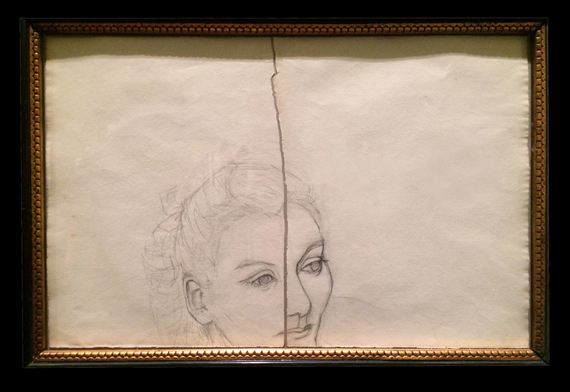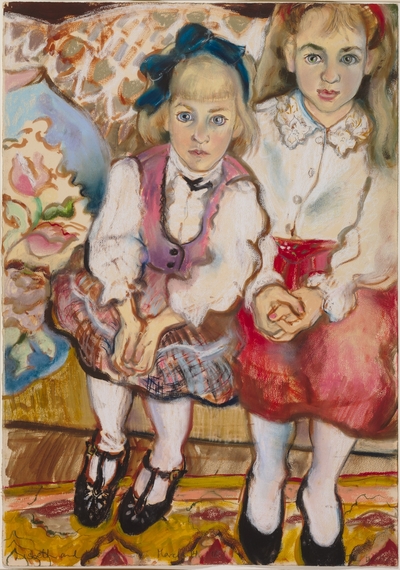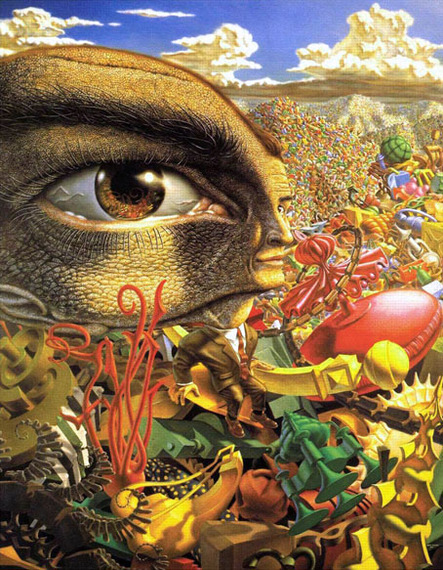Dora Maar's Self Portrait Cut in Two By a Razor (1943), black chalk (photo by the author)
The Museum of Fine Arts, is located on Beach Drive in downtown St Petersburg, overlooking Tampa Bay.
One of the current special exhibitions, Contemplating Character/Drawings and Oil Sketches from Jacques-Louis David to Lucian Freud is a thoughtfully developed portrait exhibition culled from the collection of Robert Flynn Johnson. Ranging in dates from the late 18th century to the current day, we found many intimate works that express everything from the humorous to the somber. One of the exhibition's most memorable works is Octave Tassaert's Self Portrait in Studio (1845). We see the artist as he sits, legs cross-clenched and drawing board in lap, contemplating the complexity of his subject. Using black chalk and great subtlety, especially in the face, hand and hair, Tassaert represents an intense moment of study. Purposefully, he leaves the outermost areas of the drawing sparse or unfinished to focus our attention on the transitory torment of the moment.
Ukrainian born Alexander Bogomazov worked in total anonymity his entire life. It was not until 40 years after his death that scholars discovered his artistic legacy. His expressive drawing skill is revealed in Self Portrait (1914-15). Here, we see a keen understanding of the art of his day exemplified by strong planer composition starkly contrasted by clusters of expressive accents that imply movement, energy, turmoil and change.
Dora Maar's Self Portrait Cut in Two By a Razor (1943) is one of the most stunning works in the exhibition. At one point, Maar (who most will remember as one of Picasso's mistresses) cut the paper in half so she could make two separate still life drawings on the reverse side. Fortunately, the two halves were kept together so the portrait could one day be reassembled. Seeing this work, I can't help but think about the abuses Maar may have been victim to by Picasso, who has been characterized by some art historians as cruel and belittling to the women he supposedly loved. The cut down the center of the face and the low position of the head in the picture plane speaks volumes, intended or not, about her complex and troubled life.

Anonymous, In Loving Memory, D. W. Brigs, Owner of Hardware Store, 32 Main Street, Hartford, Connecticut, Born 1826, Died 1861 (1861), graphite with white heightening on brown paper (photo by the author)
Portrait of a Young Man (1840) by Dominique Papety reminded me of the drawings of Ingres as this artist too achieves great volume with minimal shading, instead opting for descriptive, nuanced line work. One anonymous work titled In Loving Memory, D. W. Brigs, Owner of Hardware Store, 32 Main Street, Hartford, Connecticut, Born 1826, Died 1861 (1861) shows Brigs, in an open casket surrounded by items he purveyed when alive. Naively drawn in many respects, but still a powerfully haunting and rather contemporary looking work.
Hans Bellmer was best known for his later, largely disturbing surrealist work featuring jumbled female forms. Here, we see an exquisitely and sensitively drawn image of A Sleeping Man (1935) - his dreams forming an expression in his face and body of an intimate, loving engagement. A stark contrast is Robert Crumb's, Devil Woman, as she appears in a 2001 pen and ink drawing. Her domineering air, with her tongue and teeth defiantly exposed, her head crowned with a rich mane of hair, epitomizes power and control, a fine example of one of his many 'placemat drawings'.
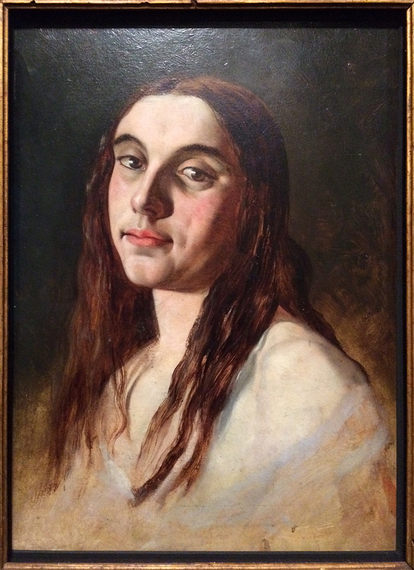
Richard Dadd, Imaginary Portrait of a Woman, Painted While in Bethlem Hospital for the Criminally Insane (1860), oil on canvas (photo by the author)
When I see the art of Richard Dadd I think of his criminal life as the murderer of his father and his ensuing mental breakdown. Despite his plight, he managed to paint some of the most sensitive, thoughtful and whimsical works of his generation. Imaginary Portrait of a Woman, Painted While in Bethlem Hospital for the Criminally Insane (1860) is a vibrant, sensuous, fleshy and revealing portrait of a woman who is as lost as she is arresting.
The Hands of Matilda, Paris 5 April, 1949 (1949) simply shows a pair of interlocking hands recorded with black ink. While drawing, the artist added water to the thick lines to make them pool. The resulting stains, gray and nebulous are organic and unpredictable, an element that adds tremendous animation suggesting the subject has little patience for sitting still. Ernest Haskell's Caricature Portrait of the English Actor Sir Henry Irving (1901) projects the actor's intensity on stage. Utilizing elongated and spindly anatomy that is half veiled behind a black cape, the actor communicates with his eyes, furrowed brow and commanding hand gesture.
Martha Miller, The Artist's Daughters (1987), pastel on paper, Collection of Robert Flynn Johnson (photo courtesy of the Museum of Fine Arts)
Martha Miller has a bit of Alice Neel in her captivating duel portrait of two girls who look like they can't wait to escape their obligation to sit still in The Artist's Daughters, Lisbeth and Kaitlyn (1987). And like the two sisters, Lucian Freud's Portrait of the Artists Mother (1984) sports a stern and distant gaze revealing her lack of interest in the process, and a sense too, that her life is rather empty and unfulfilled.
Permanent Collection Highlights
The currently featured portion of the museum's permanent collection, which numbers approximately 20,000 works, is consistent in quality and presentation throughout. The trend of combining works with similar characteristics regardless of age or era is effectively demonstrated here. Having the Seated Warrior or Guardian With Helmet and Armor, (1st - 3rd century B.C.), and Michtlantecuhtli / God of Death (c. 1100-1500), both from Mexico, displayed with the American, Diego Romero's Broke Car Landscape (1990) shows the endless narrative power that popular culture continues to evoke and inspire. Incidentally, the Seated Warrior reminded me of a work I created in 2012 titled Urchin #41, strengthening my belief in the collective unconscious.

(left) Seated Warrior or Guardian With Helmet and Armor, (1st - 3rd century B.C.), Mexico, Jalisco, Ameca Culture, buff terracotta, gift of Dr. Mark Sheppard, (right) D. Dominick Lombardi, Urchin #41 (2012), sand, acrylic medium and objects
13 X 15 X 7 inches (photos by the author)
In the next room is Mummy Mask, a 2nd century C.E. work from the Egypt, Roman Imperial period. Sporting piercing inlaid glass eyes, stylized wavy hair, lighter skin tones and a slightly plump chin, this head mounted to a black base will grab your attention from across the room.
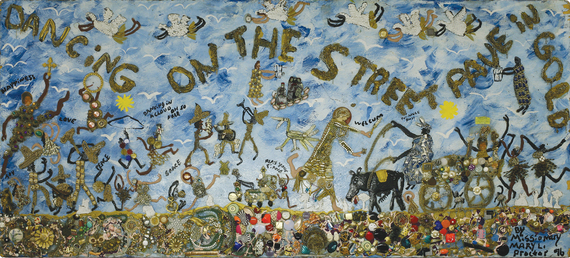
Mary L. Proctor, Dancing on the Street Pave [sic] in Gold (1996), mixed media with found objects on wooden door, gift of Donna and Thomas Brumfield Jr. (photo curtesy of the Museum of Fine Arts)
In an adjacent, and much larger room you will see works from the 20th century and beyond including Mary L. Proctors' magical mixed media on wooden door Dancing on the Street Pave (sic) in Gold (1996), Mernet Larsen's buoyant building block/figurative mixed media on canvas Walk on a Windy Day (1940), next to Lot (1987) by Markus Lüpertz, a sculpture that is raw, expressive, playful and haunting all at once.
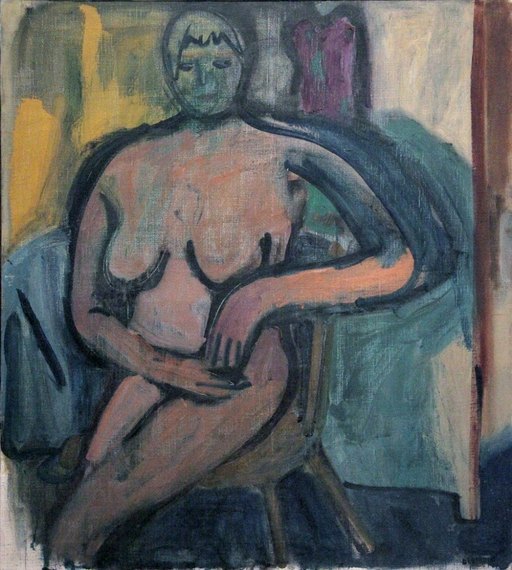
Robert De Niro, Sr., Female Nude (1960), oil on burlap, gift of Elinor Gollay from the Benjamin Gollay Collection (photo courtesy of the Museum of Fine Arts)
Other stellar works in this room are Female Nude (1960) by Robert De Niro, Sr, a painting that combines fluid line, complex perspective and brazen alterations to relay a quiet moment; Willem De Kooning's Untitled, from the Woman Series (1966), an oil on newspaper and board that has the faintest hint of its subject as it explodes into abstraction; and Kimiyo Mishima's Bâbekyûyô-Mokutan (2005), a fool the eye ceramic of a torn-open box spewing newspaper as if a treasure was just removed.
Measured Life
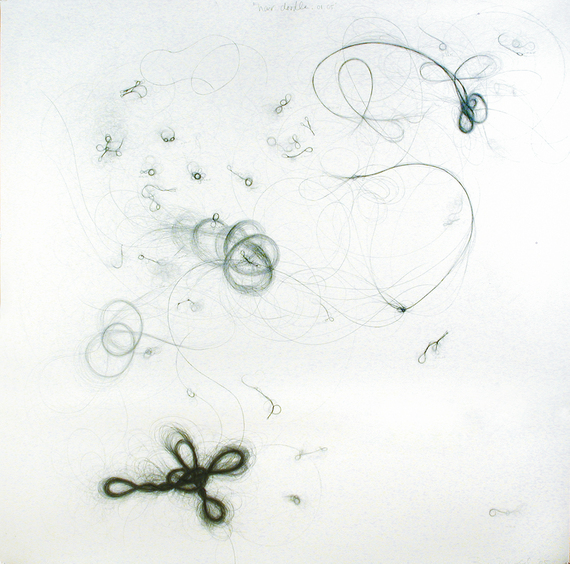
Babs Reingold, Hair Doodle: 01.05 from the series Fallout: Beauty Lost and Found (2005), graphite on paper (photo courtesy of the artist)
The second of three temporary exhibits in the museum is Measured Life, featuring the works of a trio of artists who look at the characteristics of growing old. I found Babs Reingold's two drawings to be the most compelling, as they take a very personal and revealing view of beauty that is both infinite and poetic.
More Permanent Collection Highlights

Fletcher Martin, The Undefeated (1948), oil on canvas, Museum Purchase with funds donated by the Collectors Circle (photo courtesy of the Museum of Fine Arts)
Further along in the museum's permanent collection I found myself in a room that featured striking, and sometimes surprising paintings from the first half of the 20th century. First, Fletcher Martin's The Undefeated (1948), a dynamic composition expressing a poignant moment at the conclusion of a long and bitter boxing match is pure Social Realism at its best.
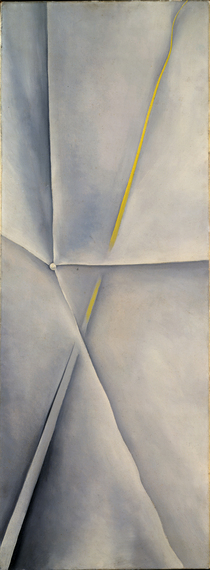
Georgia O'Keeffe, White Abstraction (Madison Avenue) (1926), oil on canvas, gift of Charles C. and Margaret Stevenson Henderson in memory of Hunt Henderson (photo courtesy of the Museum of Fine Arts)
Next is Marsden Hartley's Shell (1929). Here, the artist simply paints a glistening spiral cone cradled by a thick salmon pink drape. White Abstraction (Madison Avenue) (1926) by Georgia O'Keeffe is an amazing, small, vertical abstraction the artist claimed to be "a view looking out of the skyscraper". I'm not sure if I've ever seen anything from O'Keeffe that was quite as nondescript as this work, but it is surely one of her most mysterious.
Telephone and Sound Holes

Christian Marclay, Sound Holes (2007), suite of 21 photogravures, published by Graphicstudio/University of South Florida, Tampa, (photo courtesy of the Museum of Fine Arts)
The last of the three changing exhibition spaces has Christian Marclay: Telephones and Sound Holes, which includes a grid of 21 photogravures that show a variety of vintage speaker plates you might see in places like apartment entranceways, plus a video monitor featuring a 7:30 minute video of clips from famous films, where an actor is at the beginning, middle, or end of the phone conversation - all this in a dimly lit painted black room. Rarely is there more than one word spoken, if any, in any of the dozens of clips - a humorous and thoughtful respite in anyone's journey through the museum.
More Permanent Collection Highlights
Moving through the permanent collection in room after room I traveled back again through time, viewing one great work after another. Gino Severini's The Clown Painter (n.d.) is not the typical Futurist work he is best known for. In this instance, we see a more cynical Severini - a socio-cultural commentator that derides himself as much as he does the current state of the art world of his day. Since this painting has no date, it is difficult to be sure, but I would guess he has moved past the early luster of youthful idealism and optimism onto a plateau of reality. Another stunning work is Jean-François Raffaëlli's A Man with Two Loaves of Bread (1879). Here, the brutally real, albeit profoundly benign subject encapsulates the arduous aspects of late twentieth century peasant life to a T.
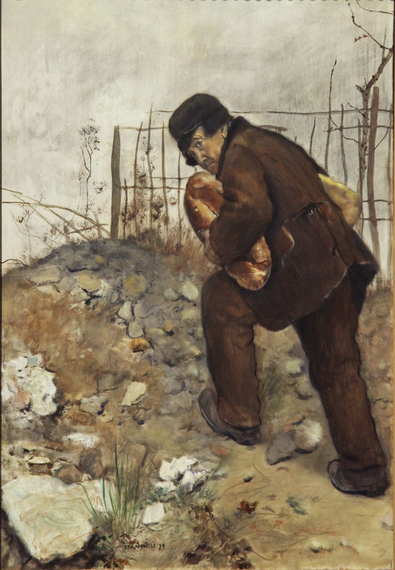
Jean-François Raffaëlli, L'homme aux deux pains (Man with Two Loaves of Bread) (1879), oil on panel, gift of the Collectors Circle (photo courtesy of the Museum of Fine Arts)
Moving further through the permanent collection, and seeing the peaceful landscape by Camile Corot titled Three Bathers Near a Wooded Point (c.1865-70) next to Paul Cezanne's exquisite Orchard, Côte Saint-Denis, at Pontoise (1877) was a rare treat. The lesser-known Eugéne Isaby, is represented with Fishing Village (1852). The very expressive paint application, combined with the cool grays, accented with touches of red and warm browns pulled me right into this nautical nightmare.
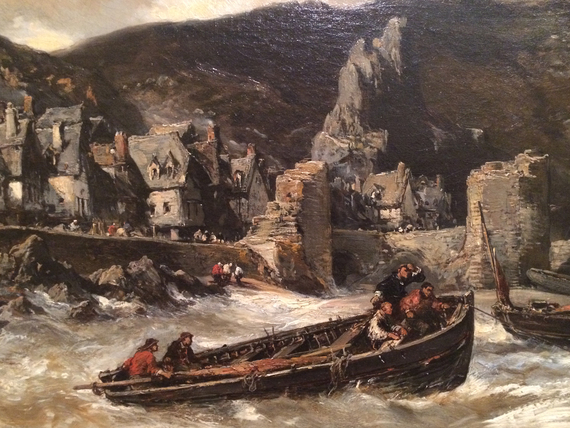
Eugéne Isabey, Fishing Village (detail) (1852), oil on canvas, museum purchase (photo by the author)
Michiel Van Mierevelt's Portrait of a Lady (1615), stunning in detail, bursting with surface texture and intensely alive, is another testament to the accomplished skill levels achieved with seventeenth century Dutch portraiture.
The Dalí Museum
The Dalí Museum is one of the biggest tourist attractions in St Petersburg. The unique architecture, its Gala Café, the lectures and films offered, and the gardens that surround the museum only add to an already stimulating experience. Seeing such a substantial presentation of works by and of such a well-known Surrealist was quite enlightening. When you visit the Dalí, I suggest that you start with what they have displayed from the permanent collection. At this time the focus is on the chronology of Dalí's aesthetic style and development.
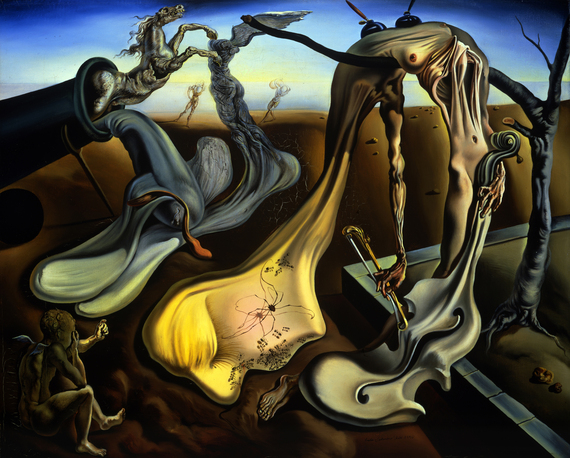
Daddy Longlegs of the Evening - Hope ! (1940), oil on canvas.
Worldwide right ©Salvador Dalí, Fundació Gala-Salvador Dalí, (Artist Rights Society), 2016 / In the USA ©Salvador Dalí Museum, Inc., St. Petersburg, FL (USA) 2016
After passing through the first room where one of Dalí's more familiar seminal works, Daddy Longlegs of the Evening - Hope! (1940), welcomes visitors, we entered a room that began with a few early, lesser-known works by the young surrealist master. Self Portrait (Figueres) (1921) is something of an awkward painting, however it is easy to see the talent hidden behind his experimental teen years.
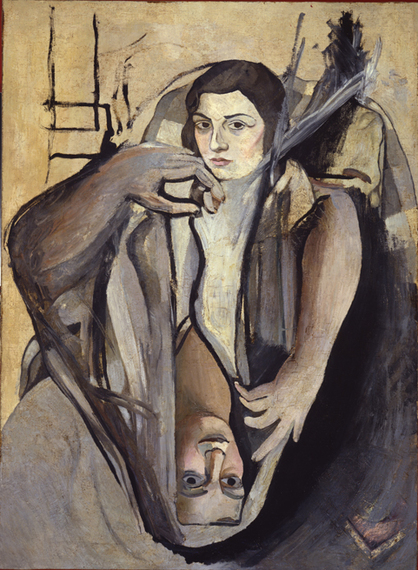
Portrait of My Sister (1923), oil on canvas. Worldwide right ©Salvador Dalí, Fundació Gala-Salvador Dalí, (Artist Rights Society), 2016 / In the USA ©Salvador Dalí Museum, Inc., St. Petersburg, FL (USA) 2016
Dalí dabbled in Impressionism with works like The Lane to Port with View of Cap Creus (1922-23), in the Neo-Classicism that Picasso mastered with Portrait of My Sister (1923), and an even more lyrical and simplistic style in Cadaqués (1923), to the tentatively composed, but confidently painted Bouquet (l'Important c'est la rose) (1926).
The first real gem in the chronology is The Basket of Bread (1926). Painted in the last months he attended art school in Madrid, Dalí creates a luminously real and precisely rendered timeless vision of something quite common. Girl's Back (1926), another wonderful painting that really got my mind churning, wondering what I wasn't seeing and who else was looking. Both works are quite small, but oh so potent.
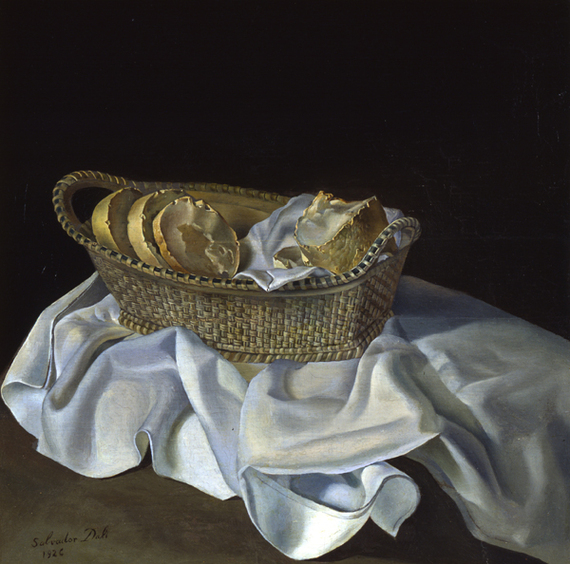
The Basket of Bread (1926), oil on panel. Worldwide right ©Salvador Dalí, Fundació Gala-Salvador Dalí, (Artist Rights Society), 2016 / In the USA ©Salvador Dalí Museum, Inc., St. Petersburg, FL (USA) 2016
There is a sense of Joan Miró in works such as Big Thumb, Beach, Moon and Decaying Bird (1928), and Yves Tanguy in Apparatus and Hand (1927) and even Hans Arp in Anthropomorphic Beach (fragment) (1928). In The Ram (1928), despite the obvious references to the styles of Miró and Max Ernst, Dalí begins to break out with the haunting rendering of a bighorn sheep. The First Days of Spring (1929), which is something of an erotic nightmare, shows the true nature of Dalí's mind.
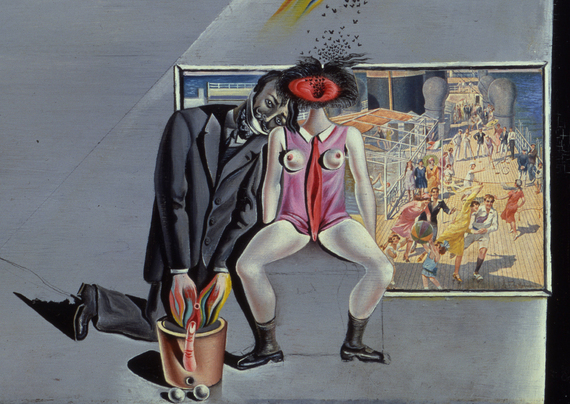
(detail) The First Days of Spring (1929), oil and collage on panel. 19.75 X 25 5/8 inches. Worldwide right ©Salvador Dalí, Fundació Gala-Salvador Dalí, (Artist Rights Society), 2016 / In the USA ©Salvador Dalí Museum, Inc., St. Petersburg, FL (USA) 2016
With oil paint and collage, Dalí creates a narrative that jumps about between sexual frustrations or fantasy and scientific fact, while the amplified perspective and highly contrasted forms that inhabit the space all command our attention.
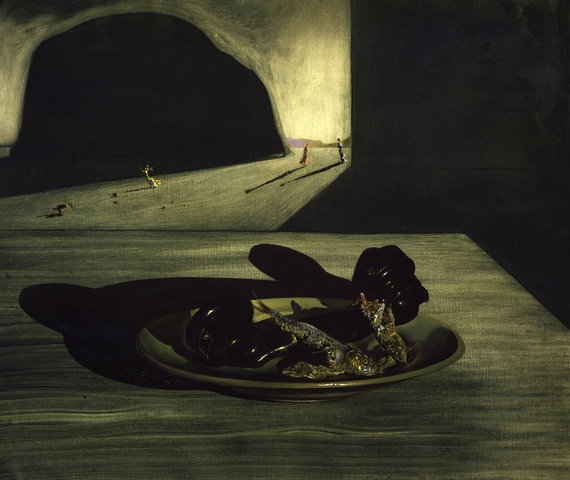
Telephone in a Dish with Three Grilled Sardines at the End of September (1939), oil on canvas. 18 X 21 5/8 inches. Worldwide right ©Salvador Dalí, Fundació Gala-Salvador Dalí, (Artist Rights Society), 2016 / In the USA ©Salvador Dalí Museum, Inc., St. Petersburg, FL (USA) 2016.
A little gem, Portrait of Gala (1932-33) utilizes overt auras, crisp realism, and contrasting values to create a lively mood, while Telephone in a Dish with Three Grilled Sardines at the End of September (1939) is a haunting image that speaks of the state of mind of Dalí and his wife Gala as they fled Spain during the Spanish Civil War. This was also a time when Dalí was expelled from the Surrealist Group after a dispute with the group's leader, Andre Breton. In the painting we see a black, disconnected, dead phone inhabiting a plate with crunchy sardines. In the background three spirits cast long shadows behind an overbearing hump of doom. I thought of Giorgio De Chirico, as Dalí utilized those same angular shadows and ephemeral figures.
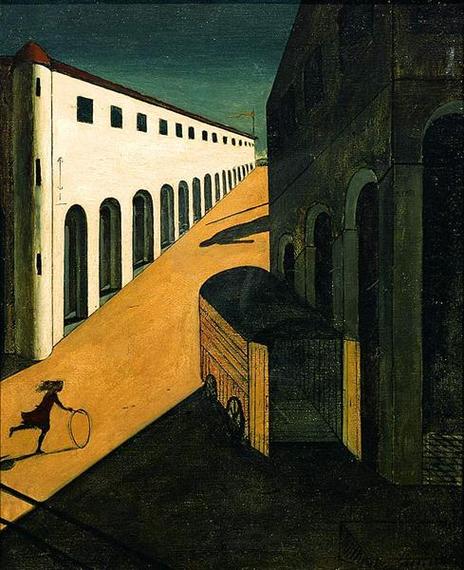
Giorgio de Chirico, Mystery and Melancholy of a Street (1914), oil on canvas, 33.4 X 27 inches (wikiart)
Jumping ahead a few years we moved to the largest works on display here: The Discovery of America By Christopher Columbus (1958-59); The Ecumenical Council (1960); and my personal favorite of the three, The Hallucinogenic Toreador (1969-70). Toreador has a few noted characteristics, most importantly, the bullfighter's face hidden in the torso of the middle Venus de Milo. It also has the vacant bull's head emerging beneath a controlled explosion of color, flanked by a parade of flies that may indicate decaying flesh.
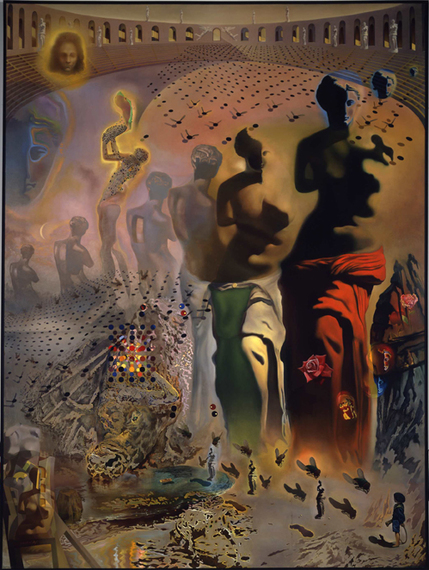
The Hallucinogenic Toreador, 1969-70, oil on canvas. 157 X 118 inches. Worldwide right ©Salvador Dalí, Fundació Gala-Salvador Dalí, (Artist Rights Society), 2016 / In the USA ©Salvador Dalí Museum, Inc., St. Petersburg, FL (USA) 2016
Here, it's all about the color scheme, the brazen use of bright yellow auras punched with soft violets and greens. That one lone, iridescent green fly that comprises the bulls left eye, the overlapping images on the bottom left, the arching stands on the top and the floating head of Voltaire just above the row of departing flies all pose an endless supply of mystery and deception.
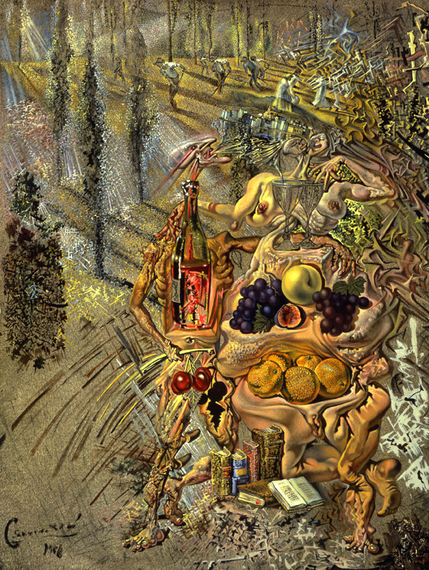
Dionysus Spitting the Complete Image of Cadaqués on the Tip of the Tongue of a Three-Storied Gaudinian Woman (1958-1960), oil on canvas. 12 ¼ x 9 inches. Worldwide right ©Salvador Dalí, Fundació Gala-Salvador Dalí, (Artist Rights Society), 2016 / In the USA ©Salvador Dalí Museum, Inc., St. Petersburg, FL (USA) 2016
What I take away from this collection of works is the influence Dalí has had on contemporary art. If you look at the bottom half of Dionysus Spitting the Complete Image of Cadaqués on the Tip of the Tongue of a Three-Storied Gaudinian Woman (1958-1960) you can't help but think of the current king of Pop Surrealism or Low Brow Art, Robert Williams.
Both use that same insanely disturbing view of the human form in all its contorted glory. If it were not for the humorous elements that tame the beastliness and brutality of either one of these artist's works it might be too hard for most to take in.
Dalí Revealed
A smaller exhibition in an adjacent room is Dalí Revealed: Photographs by Robert Descharnes. Descharnes met Dalí in 1950. They developed a bond that lasted until Dalí's death in 1989. As a collaborator on film projects with Dalí, Descharnes had many opportunities to photograph the great surrealist and did so over 60,000 times. For the exhibition, curator Dirk Armstrong selected a number of black and white prints, many staged, where Dalí and Gala played to the camera. One of the more informal and candid looking works is La Chunga, a flamenco dancer, dancing on a painting by Dalí (1958) fits the portrayed carefree life of the famous pair. Overall, we see in Dalí, a man who is confident, carefree and fun-loving with a tinge of hesitation or apprehension sprinkled in here and there - something that more than likely comes from the controlling presence of Gala, who was ten years his senior.
Disney and Dalí
The other main exhibition, Disney and Dalí, Architects of the Imagination, tells the tale of comradeship with documentation, art, animation and ideas between the two cultural giants. This friendship was apparently triggered by Dalí's time in Hollywood that began during the war years, when he hobnobbed with Hollywood stars. In 1945, Dalí produced drawings and notes for a dream sequence in Alfred Hitchcock's film Spellbound. Dalí also loved the Marx Brothers, especially Harpo Marx, while his two favorite filmmakers were Disney and Cecil B. de Mille.
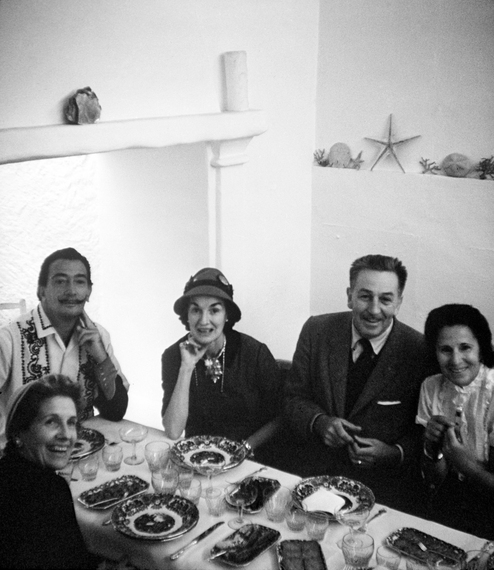
The Dalí and Disney families around the dinner table in Spain (1957), photograph, (courtesy of The Walt Disney Company, © Disney)
Disney and Dalí allied to create the animation Destino, which the two never completed for financial reasons. 58 years later in 2003, John Hench, who was originally paired with Dalí to create Destino, and Roy E. Disney, Walt's nephew, completed the seven minute animated short.
The Morean Arts Center
My purpose for being in central Florida is an exhibition I co-curated with Amanda Cooper titled Exquisite Porch. I mention this because I didn't want to just pass over this century old institution without mentioning that it is an integral part of the art community in St. Petersburg, offering a wide range of exhibitions, outreach projects, tours, classes, workshops and fundraisers. A most recent effort of the Morean to revitalize St Petersburg aside from its already pre-existing programs and institutions is SHINE St Pete Mural Festival, a project spearheaded by the Morean's Amanda Cooper, the City of St Petersburg and the St Pete Arts Alliance. The festival was in full swing in September of 2015, when artists from near and far were asked to design and execute over 10 murals throughout the downtown area.
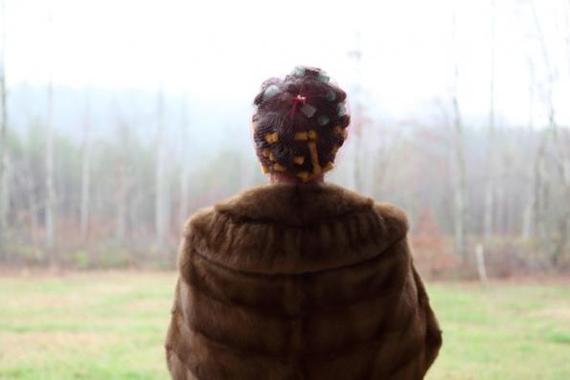
Jody Fausett, Onion Bag, from Million Years (2012), color photograph
The two exhibitions at the Morean Arts Center that opened at the same time as my visit are Jody Fausett: Crush Velvet, an Atlanta based conceptual photographer with a rather mysterious personal story to tell, and the first in a series of exhibitions featuring three successive thesis shows of seniors from the Pinellas County Center for the Arts at Gibbs High School.
The Downtown Murals
Easy to spot as you drive along Central Avenue, the murals of downtown St. Petersburg add life and vitality to some of the more tired or vacant looking sights in town. The mural by Morning Breath, the Brooklyn based design team, is by far my favorite as it shows how catchy phrasing and graphic illustrations can control one's thinking.
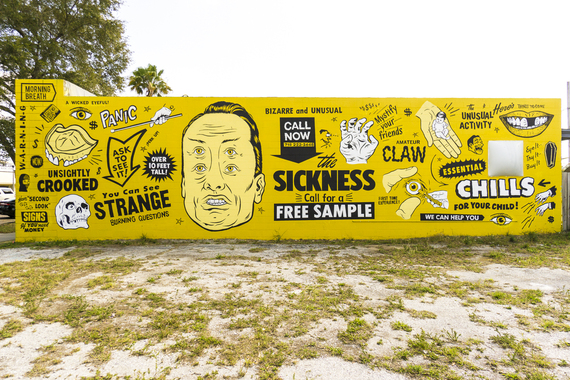
Morning Breath (artists: Doug Cunningham and Jason Noto), Mural, Downtown St Peteresburg (photo by Dale Leifeste)
I was also impressed with the mural created by the Vitale Brothers of St. Petersburg. In combining the expressive faces of active offspring with oblique patterns, bold text and the reproduced renderings of children, the trio reminds us of the fun we used to have imagining and play-acting.
Final Words
Florida native Dale Leifeste was my art and culture guide during my brief stay in St Petersburg, Florida. He proved to be invaluable as he helped me navigate my way through St Petersburg's art institutions, area eateries, white sand beaches, unspoiled parks and commercial attractions. I have to mention that Sawgrass Lake Park is a great place for a leisurely walk. The elevated boardwalk makes it easy and accessible by all.
If you love smoked fish you have to stop by Ted Peters Famous Smoked Fish. Another great place to find a fun fish lunch or dinner is the Crab Shack Restaurant. My wife Diane felt "All the food choices are good and affordable. Of special mention, as it holds a sweet spot in my memory to this type of dining, is the Crab Shack. Having tasted a bit of my husband and friend's dinners I am aware that they know how to prepare any number of fish dishes either grilled, fried, with sauce over pasta, etc. I opted to order simple and light with pristinely fresh raw oysters for my appetizer, followed by fresh, cooked-to-perfection, medium raw tuna steak, house made coleslaw, and a mammoth baked potato simply topped like the old days, with butter and sour cream. I must emphasize, that this potato, plain and simple, has the flavor of an old fashioned American baked potato grown in good soil with great starter potato eyes. Baked potatoes are not all what they used to be decades ago, so I must praise the restaurant and the farmer that grew it for this special treat."
If you are looking for something more romantic, try the outdoor dining section of Red Mesa Cantina & Lunch Bar. As Diane noted, all three are reasonably priced, especially from vantage point of a visiting New Yorker. For a combination of beach and seaside dining I'd recommend Little Tommies Tiki or any of the other eateries in Gulfport. We really felt like we stepped back a bit in time to a more unspoiled age.
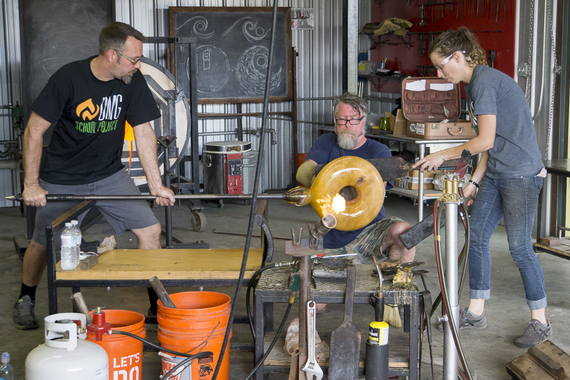
From left to right: Paul J. Nelson, John Miller and Mariel Bass, The Duncan McClellan Gallery, Hotglass Workshop Demonstration (2016) (photo Dale Leifeste)
You also don't want to miss Duncan McClellan Gallery in St. Petersburg's Warehouse Arts District. Featured artists often give glass blowing demonstrations and I hear that their openings are fun and festive.

